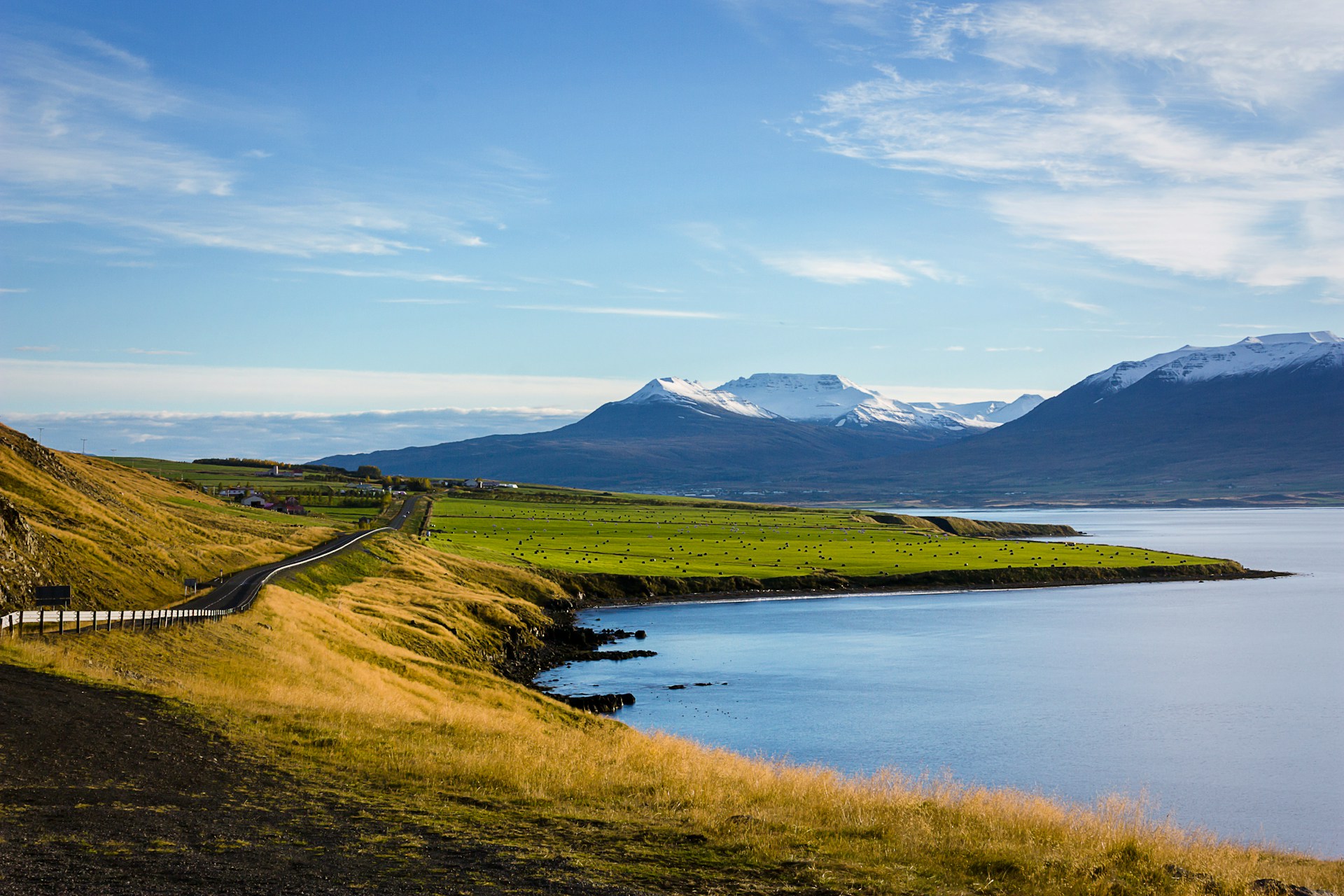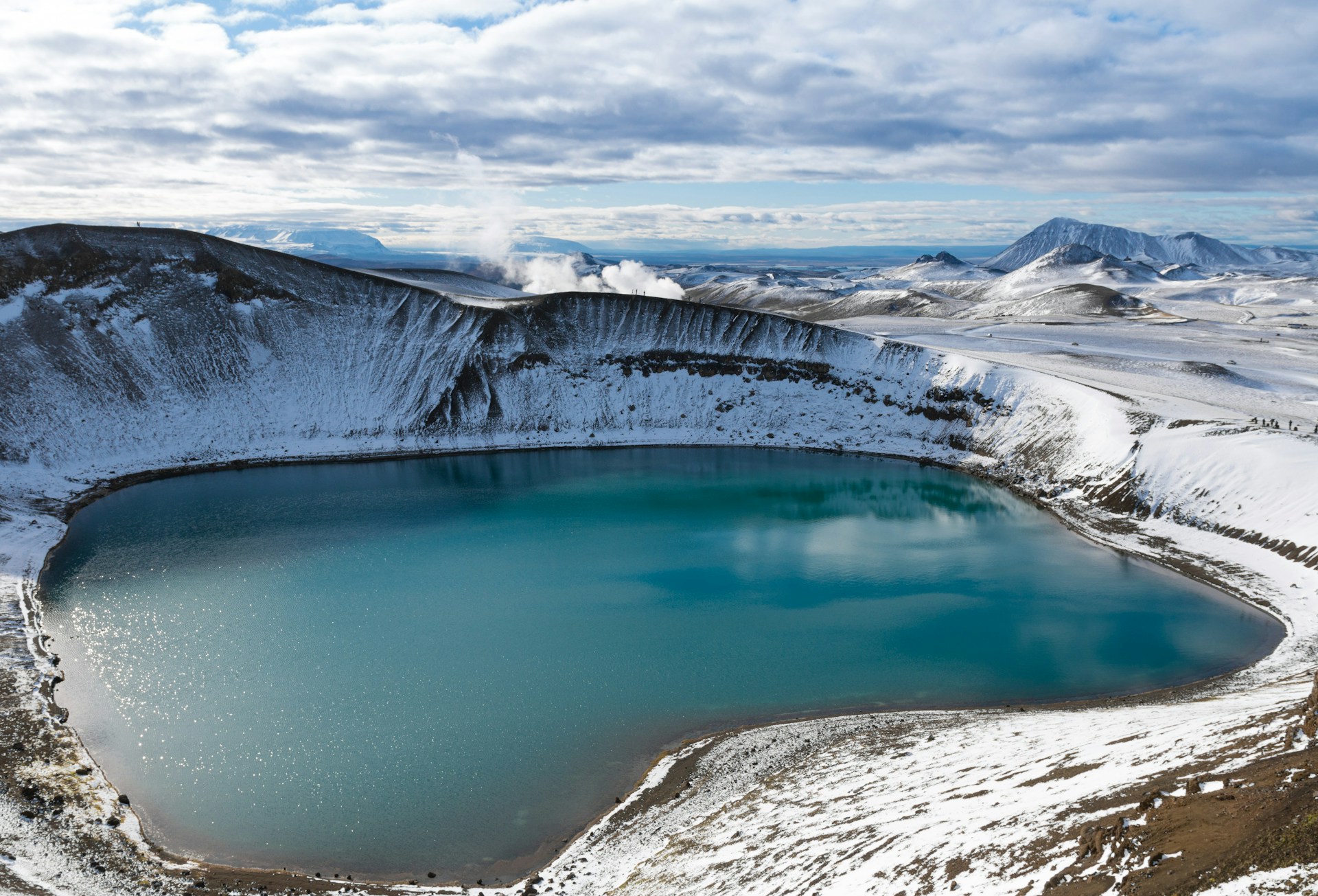Iceland, a land of mystique with its dramatic landscapes, entices travelers worldwide. Among its many treasures is the Golden Circle, a popular tourist route renowned for its breathtaking natural beauty. This iconic route, known as Iceland's Golden Circle, is celebrated for its must-see attractions and unforgettable scenery.
This blog post aims to guide you through the best time to visit the Golden Circle, ensuring your journey is as magical as the destination.
Introduction to the Golden Circle
The Golden Circle is one of Iceland’s most iconic routes, drawing visitors from around the world to experience the country’s extraordinary natural beauty and geological significance. Located in South Iceland, the Golden Circle route covers approximately 300 kilometers and features three of the nation’s most celebrated attractions: Thingvellir National Park, the Geysir Geothermal Area, and Gullfoss Waterfall. This journey through stunning landscapes offers a unique glimpse into Iceland’s rich cultural heritage, from ancient meeting places to powerful geothermal areas. Whether you choose a guided Golden Circle tour or prefer to explore at your own pace, the route promises an unforgettable adventure through some of the most breathtaking scenery in the entire country.
Golden Circle Route
The Golden Circle route is a well-marked and easily accessible path that showcases the very best of Iceland’s natural wonders. Starting just a short drive from Reykjavik, the journey leads east to Thingvellir National Park, a UNESCO World Heritage Site renowned for its geological and historical importance. Here, visitors can walk through the dramatic rift valley where the North American and Eurasian tectonic plates meet, marveling at the park’s unique rock formations and the surrounding landscape. Continuing along the Golden Circle route, the next stop is the Geysir Geothermal Area, famous for its bubbling mud pools, steaming vents, and the spectacular eruptions of Strokkur geyser. The final highlight is Gullfoss Waterfall, where thundering waters plunge into a rugged canyon, creating one of Iceland’s most iconic views. With its blend of hot springs, rift valleys, and cultural heritage, the Golden Circle route is a fantastic way to experience the natural beauty and geological wonders of South Iceland.
Best Time to Visit the Golden Circle: A Month Overview
January - The Winter Wonderland

January ushers in the heart of Icelandic winter, an ethereal time when the Golden Circle is transformed into a breathtaking, snow-dusted wonderland. The mercury hovers around -1 °C to -4 °C, bringing a crisp, cold air that blankets the landscapes, turning rivers into icy sculptures and adorning waterfalls with frosty crowns.
Daylight is scarce, offering a mere 4-5 hours of sunshine, but it paints the sky in a palette of pastel hues during sunrise and sunset, casting a soft glow on the stark, wintry landscapes. It’s a sight to behold, like stepping into a beautifully crafted snow globe.
Tourist volume in January is comparatively low, creating a sense of serene solitude that complements the wintry landscapes perfectly. The quiet winter roads lead the way to Gullfoss waterfall, which, under the winter sun, offers an astounding view of thundering waterfalls, with rainbow arcs shimmering within the frosty mist and the dramatic power of the falls heightened by the icy surroundings.
But the natural spectacle unfolds as night falls - the dark, clear skies create ideal conditions for witnessing the awe-inspiring phenomenon of the Northern Lights. Dancing in green, pink, and purple waves across the sky, they transform the nights into a mesmerizing light show.
If you’re willing to brave the chill, January’s Golden Circle experience is magical.
February - Embrace the Cold
.avif)
February in Iceland continues the winter season, with average temperatures similar to January, ranging from -1°C to -3°C. Snow frequently blankets the landscapes, turning the Golden Circle into a frozen tableau punctuated by the stark contrasts of dark volcanic rocks and the pristine white snow.
Towards the end of the month, there’s a noticeable change as daylight stretches a little longer, with approximately 7-10 hours of light per day. The lengthening days, coupled with the often clear skies, serve as a gorgeous backdrop for the sun that hangs low in the sky, washing the icy landscapes with hues of gold.
The tourist volume remains moderate in February, so you can often enjoy the remarkable landmarks in relative peace. The persistent cold may be challenging for some, but those who embrace it are rewarded with stunning sights.
The Gullfoss waterfall’s mighty cascade partially freezes, creating a surreal blend of moving and static water formations. Meanwhile, the geysers of Haukadalur continue to erupt, sending boiling water and steam skyward, providing a stunning contrast to the chilly surroundings.
The extended hours of darkness still make this month an excellent time for Northern Lights viewing, especially on clear nights away from city lights. February’s Golden Circle tour provides an enduring winter charm, full of beauty for those prepared to embrace the cold.
March - Farewell to Winter
.avif)
March in Iceland signifies a shift from the winter chill to the onset of Spring, as average temperatures gently rise to approximately 0°C-3°C. While the month typically starts with winter’s grip still evident across the landscape, the progression of days gradually introduces the essence of Spring, subtly transforming the scenery of the Golden Circle.
The snow begins to retreat from lower altitudes, and the days grow noticeably longer, with daylight spanning up to 12 hours by the end of the month. The low-hanging sun continues to cast a golden hue over the land, the soft light emphasizing the stark beauty of the transitioning landscapes.
With this seasonal transition, tourist numbers slowly increase, yet it still needs to catch up to the summer crowds. March is an excellent time for those seeking a balanced experience—milder weather, longer daylight hours, and fewer tourists than peak season.
Attractions like Thingvellir National Park reveal the first signs of thawing, with melting ice unveiling the park’s fascinating geological formations. The increasing flow due to melting snow adds to the waterfall’s might at Gullfoss waterfall, making it an even more awe-inspiring sight. Spring is also a great time to experience all the waterfalls along the Golden Circle as they reach their peak flow.
If the sky is clear, early March still provides opportunities to see the Northern Lights. In essence, March offers a unique blend of seasons, a touch of winter magic, and the promise of Spring’s renewal.
April - Awakening of Spring
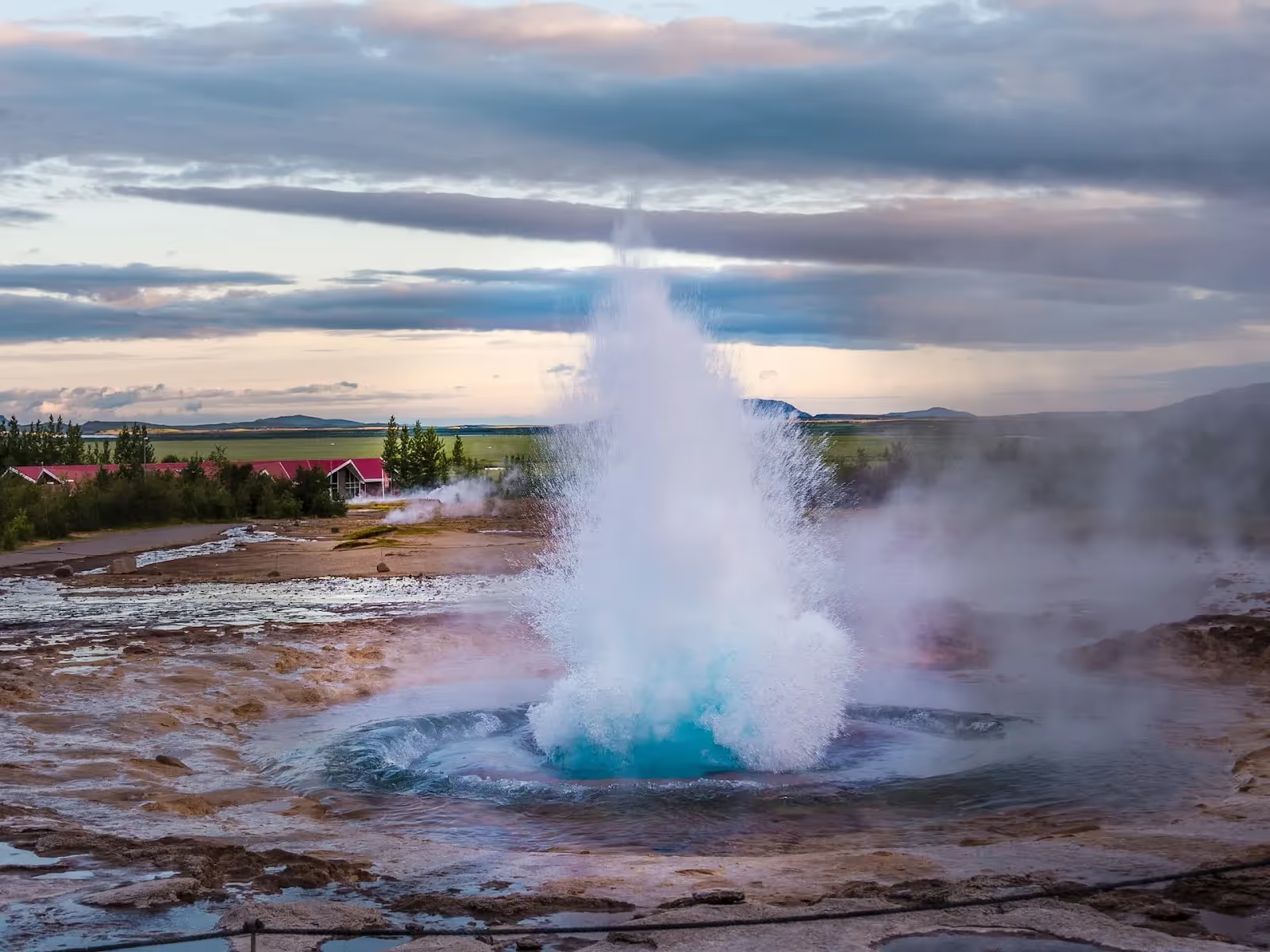
April in the Golden Circle signifies the full onset of SpringSpring. With temperatures climbing to an average of 3°C-7°C, the landscapes begin to shake off their winter white mantle.
Patches of green emerge from rivers and waterfalls, increase their flow with the melting ice, and the land awakens to the promise of warmer days. The daylight hours continue to extend, reaching up to 14-16 hours towards the end of the month, which allows for longer exploration times and the chance to experience Iceland’s stunning sunsets.
The influx of tourists remains moderate in April, making it an ideal time for travelers who prefer less crowded attractions. As the ice recedes in Thingvellir National Park, the rift valley’s rugged charm becomes more apparent, revealing the stark boundary between the North American and Eurasian tectonic plates. The park is also home to Lake Thingvallavatn, Iceland’s largest lake, which is significant for its geological features and abundant birdlife.
The increased water flow at Gullfoss adds to the waterfall’s grandeur, the mighty cascade being a mesmerizing sight against Spring’s soft colors. Meanwhile, the geysers of Haukadalur maintain their steady activity, with the main geyser, Strokkur, putting on its spectacular water display every 6-10 minutes.
The arrival of Spring in April offers visitors the chance to witness the Golden Circle blooming back to life, an experience both refreshing and invigorating.
May - Spring in Full Bloom
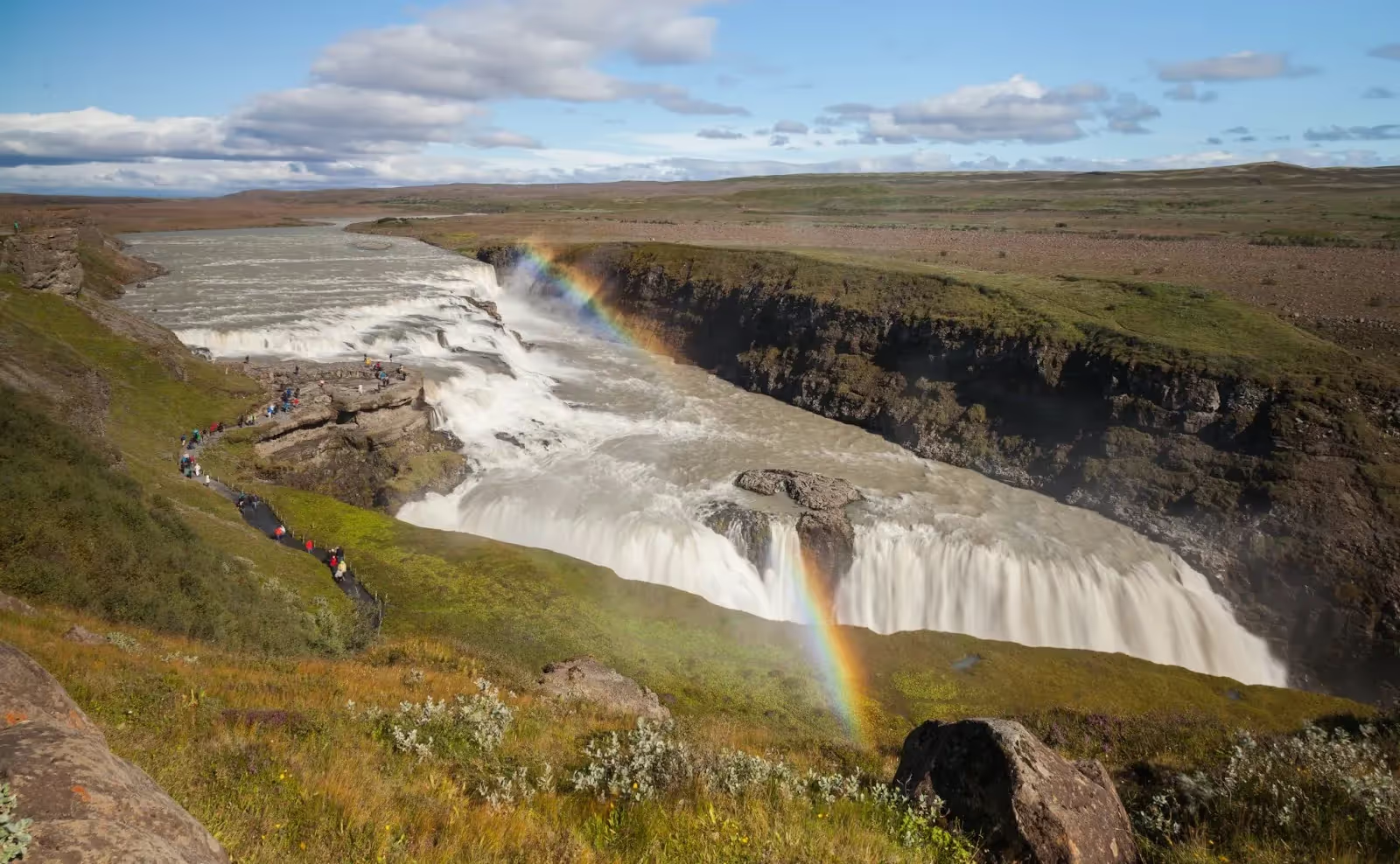
May brings the full flourish of SpringSpring to the Golden Circle, a scenic region in Iceland's southern uplands, with temperatures settling between 6°C-11°C. As the last vestiges of winter disappear, landscapes transform into vibrant expanses of green dotted with an array of blooming wildflowers.
Rivers and streams, fed by melted ice, gush with renewed vitality. Extended daylight, reaching 18-20 hours towards the end of the month, bathes the landscapes in a mesmerizing soft light, offering longer days for exploration and painting the skies with spectacularly vivid sunsets.
The life surge in May attracts more tourists, yet it is still less crowded than the peak summer months. It is the ideal month for hiking enthusiasts as trails in Thingvellir National Park become more accessible, revealing awe-inspiring geological formations and abundant birdlife nesting near the shores of Lake Þingvallavatn.
Gullfoss waterfall continues to roar with springtime flow, its mist creating rainbows that add an enchanting touch to the already stunning view. The contrast of the erupting hot water against the verdant surroundings is a sight to behold at the Geysir geothermal area.
May’s bountiful daylight and blossoming landscapes make it a delightful time to experience the Golden Circle in all its springtime glory.
June - The Midnight Sun

June marks the beginning of summer in Iceland, with average temperatures ranging from 9°C-14°C. It’s a time when the Golden Circle truly comes alive under the phenomenon known as the “Midnight Sun.”
This natural spectacle, which provides almost 24 hours of daylight, gives the landscapes an otherworldly glow and an ethereal sense of timelessness. The terrain is lush and vibrant, dotted with wildflowers, while rivers and waterfalls sparkle under the prolonged sunshine.
The longer daylight hours and favorable weather conditions attract more visitors, marking the beginning of the peak tourist season. However, the abundance of light allows for flexible touring schedules.
To avoid the crowds, consider exploring the attractions either very early in the morning or late in the evening. Thanks to the Midnight Sun, activities like hiking in Thingvellir National Park can be enjoyed until late at night.
Similarly, the Geysir geothermal area and the Gullfoss waterfall can be visited at unconventional hours, providing a unique perspective of these natural wonders under the ethereal midnight light. June’s prolonged sunlight also opens up opportunities for additional activities like horseback riding, river rafting, or fishing, providing a unique blend of adventure and tranquility in the heart of the Golden Circle.
July - The Peak of Summer

July brings the peak of summer to the Golden Circle, with temperatures pleasantly hovering around 11°C-15°C and occasionally reaching up to 20°C. The landscapes during this time are in full bloom, with vibrant hues of green, bursts of wildflower colors, and clear, sparkling rivers and waterfalls.
The daylight hours are still near their maximum, offering around 20-24 hours of light, allowing the Midnight Sun phenomenon to continue casting its enchanting glow over the region. The favorable weather conditions and extended daylight make July one of the busiest months in terms of tourist volume.
Despite the influx, the sense of tranquility isn’t lost, thanks to the vastness of the Golden Circle’s landscapes. All attractions are at their most accessible during this month. Thingvellir National Park is a riot of colors, inviting for hiking, picnicking, and even snorkeling in the Silfra fissure.
Gullfoss waterfall roars with summer rains and melting glacial water, creating a mesmerizing spectacle, while the Geysir geothermal area is alive with activity. The peak of summer also brings local festivals and cultural events, offering an additional layer to your Golden Circle experience. Many of these events feature opportunities to see the Icelandic horse, with farm exhibits, shows, and guided rides that highlight its cultural heritage and importance in Icelandic farm life.
With its long days and bountiful attractions, July offers a total immersion into the Icelandic summer.
August - The Mild Summer
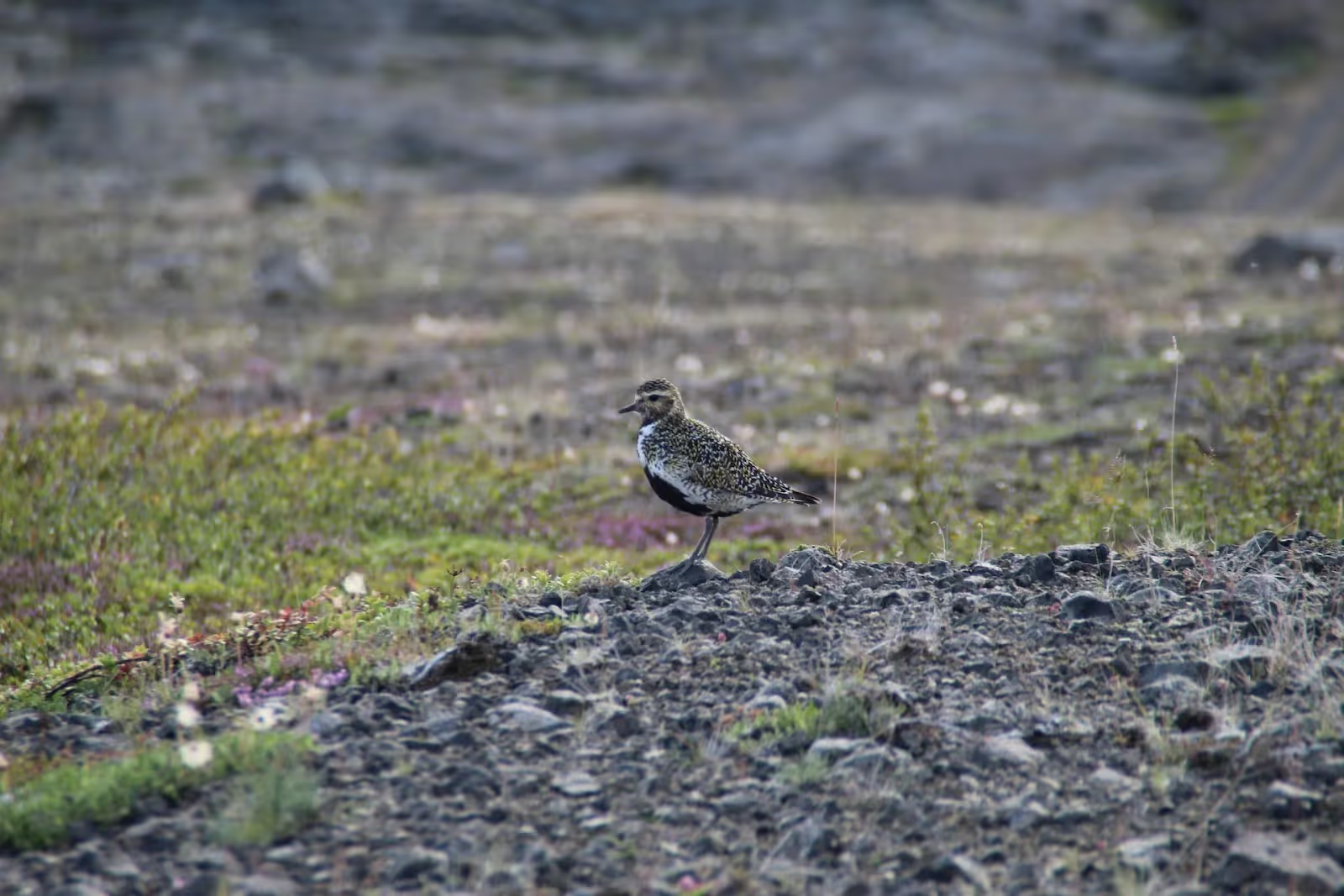
August in the Golden Circle signifies a mild summer, with temperatures gently descending to a comfortable range of 10°C-14°C. This month witnesses subtle shifts in the landscape as the vibrant summer hues start to soften, hinting at the onset of Autumn.
The days remain long, though they gradually start losing hours towards the end of the month, providing a beautiful balance of daylight and twilight hours. The easing of tourist volume and the mild weather make August an ideal time for various activities.
Hiking in Thingvellir National Park continues to be a delight, with the added allure of witnessing early signs of fall colors. The waters of Gullfoss Waterfall remain abundant and awe-inspiring, and the geysers at Haukadalur are as active as ever.
August is also a prime time for wildlife enthusiasts as bird-watching peaks, allowing them to spot species like the golden plover before they migrate. As the nights darken towards the end of the month, you may even get lucky with early sightings of the Northern Lights.
In essence, August brings the gentle close of summer with a whisper of what's to come in the changing seasons.
September - Autumnal Beauty

September brings Autumn to the Golden Circle, with average temperatures dropping to around 6°C-11°C. The landscapes transition into a tapestry of rich autumnal colors.
Lush greens gradually give way to shades of yellow, orange, and red, lending a rustic charm to the region. The days continue to shorten, with daylight between 12-15 hours, creating a cozy balance between daytime explorations and early evening relaxation.
Tourist volumes significantly decreased in September, providing a more peaceful and personal experience at various attractions. Thingvellir National Park is a visual treat, its vast expanse adorned with a riot of fall colors. The vibrant hues of Kerid Crater, with its colorful rocks and striking blue waters, make it a must-see autumn stop along the Golden Circle.
Gullfoss waterfall, contrasting against the autumnal backdrop, becomes even more picturesque. The geysers of Haukadalur offer a constant contrast to the changing colors, their eruptions standing out vividly against the rustic landscape.
As the nights grow longer, the chances of viewing the Northern Lights increase, especially towards the end of the month. With its crisp air, changing colors, and less crowded attractions, September presents an enchanting blend of tranquility and beauty, making it a great time to visit the Golden Circle.
October - The Autumn's Farewell

November heralds the arrival of winter in the Golden Circle, with temperatures dropping to -2°C-4°C. The landscape transitions into its winter cloak, with the first snowfall usually arriving and turning the area into a beautiful winter wonderland.
The daylight diminishes significantly during this month, with only 5-8 hours of light each day. This reduction casts a serene, almost mystical, ambiance over the region, emphasizing the stark, snow-covered landscapes.
Tourist volumes are low in November, providing a peaceful environment for those who don’t mind braving the chill. Winter activities start to come into focus, with attractions like Thingvellir National Park taking on a new identity under the blanket of snow. Thingvellir sits on the Mid-Atlantic Ridge, where the North American and Eurasian tectonic plates meet, creating dramatic geological features that are especially striking in winter.
Gullfoss waterfall, while slower, freezes partially to create a fantastic spectacle of icicles and snow-covered rocks. The geysers of Haukadalur also take on a different persona, their steamy eruptions contrasting dramatically against the cold air.
As darkness dominates more of the day, opportunities for viewing the Northern Lights increase, adding an extra layer of attraction for visitors. The arrival of winter in November marks the onset of a magical, frost-laden experience in the Golden Circle.
November - The Arrival of Winter
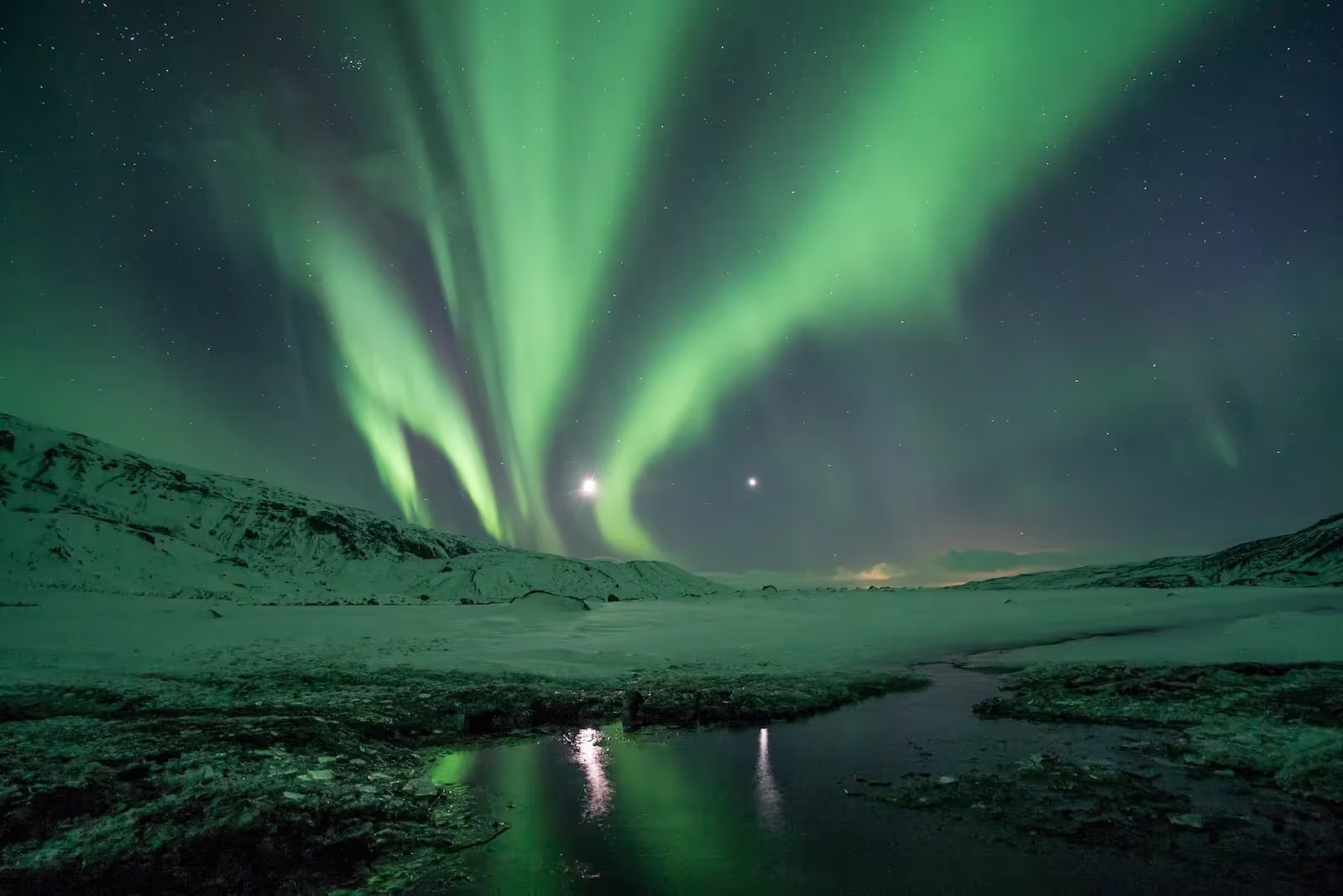
November heralds the arrival of winter in the Golden Circle, with temperatures dropping to -2°C-4°C. The landscape transitions into its winter cloak, with the first snowfall usually arriving and turning the area into a beautiful winter wonderland.
The daylight diminishes significantly during this month, with only 5-8 hours of light each day. This reduction casts a serene, almost mystical, ambiance over the region, emphasizing the stark, snow-covered landscapes.
Tourist volumes are low in November, providing a peaceful environment for those who don't mind braving the chill. Winter activities start to come into focus, with attractions like Thingvellir National Park taking on a new identity under the blanket of snow.
Gullfoss waterfall, while slower, freezes partially to create a fantastic spectacle of icicles and snow-covered rocks. The geysers of Haukadalur also take on a different persona, their steamy eruptions contrasting dramatically against the cold air.
As darkness dominates more of the day, opportunities for viewing the Northern Lights increase, adding an extra layer of attraction for visitors. The arrival of winter in November marks the onset of a magical, frost-laden experience in the Golden Circle.
December - The Magical Winter

December sees the Golden Circle in the grip of winter, with temperatures averaging between -3 °C and 2°C. A beautiful yet harsh landscape of snow and ice marks this month. The daylight hours are at their shortest, with only 4-5 hours of light each day, creating an atmosphere of perpetual twilight during the daytime.
When it does make an appearance, the low-angled sun casts a beautiful golden light over the snowy landscapes, creating a stark yet ethereal view that’s uniquely Icelandic. The visitor volume in December is relatively low, making it an ideal time for those seeking solitude and tranquility.
The main attractions of the Golden Circle, including Thingvellir National Park, Gullfoss waterfall, and the geysers at Haukadalur, showcase their winter personas, each providing a different perspective on the raw power and beauty of nature under the winter sky. December is also the time of traditional Icelandic Christmas celebrations, which can be experienced in nearby towns, adding a cultural dimension to your visit.
The highlight of the winter, however, remains the Northern Lights. Their magical dance across the night sky is a spectacle of color and movement that serves as the perfect topping to the winter charm of the Golden Circle in December.
On the final day of your winter trip, consider making the most of your time by enjoying the Northern Lights once more or participating in traditional Icelandic celebrations to end your journey on a memorable note.
Hidden Gems Along the Golden Circle
Beyond the famous trio of attractions, the Golden Circle is dotted with hidden gems that offer a more intimate look at Iceland’s stunning landscapes and local life. One such hidden gem is the Secret Lagoon in Fludir, a natural hot spring where you can soak in warm waters surrounded by steam and scenic views—a perfect way to unwind after a day of exploring. Another lesser-known spot is Thorufoss Waterfall, tucked away just off the main road, where you can enjoy a peaceful picnic or a scenic hike without the crowds. The countryside along the Golden Circle route is also home to charming horse farms, traditional Icelandic villages, and dramatic cliffs, providing plenty of opportunities to discover the region’s rural character. For those willing to venture off the beaten path, the Golden Circle offers countless chances to find your own hidden gems and create unforgettable memories.
Accommodations and Dining Options
Travelers along the Golden Circle route will find a wide range of accommodations and dining options to suit every taste and budget. From luxurious hotels with panoramic views to cozy guesthouses and welcoming farm stays, there’s something for everyone looking to experience Iceland’s warm hospitality. Many restaurants and cafes along the Golden Circle serve delicious food made from local ingredients, including fresh seafood, tender lamb, and creamy Skyr yoghurt. Adventurous eaters can sample unique Icelandic specialties like tomato beer or rye bread baked using geothermal energy. Whether you’re seeking a romantic dinner with a view, a hearty meal after a day of adventure, or a taste of traditional Icelandic cuisine, the Golden Circle route offers plenty of opportunities to enjoy fantastic food and memorable stays as you explore this remarkable region.
Tips and Considerations When Choosing When to Visit Golden Circle
When deciding on the best time to visit the Golden Circle in Iceland, consider the following top five tips and considerations:
The Golden Circle is a popular day trip from Reykjavik, making it an accessible option for travelers with limited time who want to experience Iceland's highlights in a single day.
Prioritize Natural Phenomena
Determine whether you want to see the Northern Lights or experience the midnight sun. Northern Lights are typically visible from late September to early April, while the midnight sun occurs during summer, especially in June and July.
Weather Conditions
Icelandic weather can be unpredictable and varies significantly between seasons. Summers offer milder temperatures and longer days, ideal for extended exploration, whereas winters are cold but provide a unique, snowy landscape. Changing weather can dramatically alter the appearance of the region's rugged cliffs and landscapes, creating ever-shifting scenic views.
Always check the forecast and prepare for sudden changes in weather.
Crowd Levels
Peak tourist season in Iceland is during the summer, from June to August. If you prefer a less crowded experience, consider visiting in the shoulder months (April, May, September, October) when there are fewer tourists, but the weather remains relatively mild.
Driving Conditions
If you plan to drive, note that winter conditions can be challenging with icy roads and limited visibility. Summer offers easier driving conditions, making it a better option for those not experienced in winter driving. While the Golden Circle is a popular short route, driving the longer ring road that circles Iceland offers a more extensive experience, connecting diverse landscapes and requiring more days to complete.
Always rent a suitable vehicle for the season.
Duration of Daylight
Daylight hours vary drastically in Iceland. During winter, daylight is limited, which might restrict your sightseeing time, but it is ideal for Northern Lights viewing. Summer provides almost 24 hours of daylight, allowing more time for activities and exploration.
Consider how this will impact your itinerary.
Considering these factors, you can choose the best time to visit the Golden Circle that aligns with your interests and comfort with varying conditions.
Conclusion
The Golden Circle’s ever-changing landscapes and climatic variations position it as a year-round destination, each month unveiling its distinct charm. Its stunning landmarks are a key reason for its enduring appeal, drawing visitors eager to witness these iconic sights in every season. Experience the ethereal glow of the Midnight Sun in summer, complemented by long daylight hours, or witness the magical Northern Lights in winter.
The vibrant spring blooms and Autumn’s rustic hues further enhance the allure of the Golden Circle route. No matter when you visit, the Golden Circle promises a rich, fulfilling, and unforgettable experience.
Our array of meticulously curated Golden Circle tours lets you explore the beauty of Iceland’s Golden Circle in all its seasonal splendor. From hot springs to the majestic Golden Falls and the stunning south coast, our tours offer a blend of hiking adventures and cultural experiences tailored for an authentic Icelandic adventure.
Whether you’re a solo traveler eager to explore at your own pace, a couple seeking a romantic escape, or a family looking for a holiday filled with fun and learning, we cater to all. Dive into our wide range of Golden Circle attractions on our website and embark on your perfect Icelandic journey today!


.webp)



